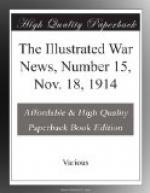[Illustration: Commander of the British cruiser which “Imprisoned” The “KOeNIGSBERG”: Captain Sidney R. Drury-Lowe, R.N.]
The Admiralty stated on Nov. 11, “This search resulted on Oct. 30 in the ‘Koenigsberg’ being discovered by H.M.S. ‘Chatham’ (Captain Sidney R. Drury-Lowe, R.N.) hiding in shoal water about six miles up the Rufigi Ritter.... (German East Africa) ... She is now imprisoned, and unable to do any further harm.”—[Photo. by Elliott and Fry.]
[Illustration: Commander of the Australian cruiser which destroyed the “Emden”: Captain John C.T. Glossop, R.N.]
Captain Glossop received the following message from the First Lord of the Admiralty: “Warmest congratulations on the brilliant entry of the Australian Navy into the war, and the signal service rendered to the Allied cause and to peaceful commerce by the destruction of the ‘Emden.’”
Photograph by Lafayette.
[Illustration: One of the vessels concerned in “The large combined operation” Against the “Emden” H.M.A.S. “Melbourne.”]
While it fell to H.M.A.S. “Sydney” to bring the “Emden” to action, another vessel of the Australian Navy, the “Melbourne,” also joined in the pursuit. The Admiralty stated that a “large combined operation by fast cruisers against the ‘Emden’ has been for some time in progress. In this search, which covered an immense area, the British cruisers have been aided by French, Russian, and Japanese vessels working in harmony. H.M.A.S. ‘Melbourne’ and ‘Sydney’ were also included in these movements.”
Photograph by Sport and General.
At whatever sacrifice! And that promises to be terrible. For what will be the sacrifice entailed by two years of war—to put its duration at a moderate estimate—if our casualties in life and limb alone (compared with which our millions of money are as nothing) amounted, according to an official statement in Parliament, to about 57,000 of all ranks up to the end of October, and it is believed that 10,000 at least must be added for the first ten days of November? Of course, by far the larger portion of those casualties are “wounded,” of whom, according to one of the Netley authorities, nine in ten at least ought to recover; while those casualties also include “missing,” or “prisoners,” of whom the Germans claim to have now more than 16,000 in their keeping. In the Boer War our “wounded” amounted to 22,829, of which only 2018 proved fatal cases; while our total casualties for over two and a-half years of warfare, including 13,250 deaths from disease—which, in every campaign, is always far more fatal than lead or steel—figured up to 52,204, as compared with 57,000 in France and Belgium for only three months, or considerably more than twice the number of men (26,000) whom we landed in the Crimea; while the purely British contingent of Wellington’s “Allies” at Waterloo was returned at something like 24,000.




